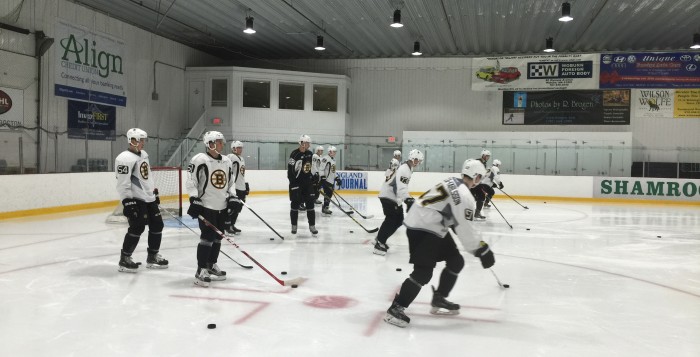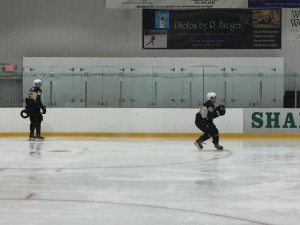Bruins Development Camp: Shuttles and Tires?
Today marked the first day of the 2015 Boston Bruins Development Camp at which 36 of the 37 players attended. Unfortunately Joonas Kemppainen has had to sit out the start because of an injury to his hamstring. However, according to Development Coach Jay Pandolfo, there is hope that he will be able to make a showing during this week.
The remaining 36 players consisted of the 10 newest prospects, drafted at the end of June in the 2015 NHL Entry Draft; four from 2014; three from 2013, two from 2012, one from 2011; one from 2010; one via trade; six through free agent signings; and nine camp invites. That’s a lot of hockey players and, as often happens at this time of the year, they have been broken up into two groups, rotating who gets the early on-ice practice.
However, before they could lace up the skates and get out on that rink, they first had to go through the physical fitness tests—including the much dreaded shuttle runs. In his third blog installment, on the Bruins site, Jake DeBrusk compared the anxiety of the shuttle run to that of the Wingate or VO2 during the Combine.
The players are honest with themselves and with the media when asked about how they think things are going..
“We had some off-ice testing so I think I didn’t do pretty good,” said the number 13 overall pick in June, Jakub Zboril. “I’m not in the best shape right now.”
He felt more confident about his work on-ice, but his comments speak to one of the many important reasons that the NHL teams hold the development camps every year. For some of the players it is an eye-opener to how they should be arriving at camp and what it means to practice and ultimately play at the NHL level.
While strength and conditioning coach John Whitesides was present for this morning’s tests, he apparently hasn’t yet had his heart-to-heart with the camp attendees. Zborik is expecting to be called out though.
“I think that will come,” Zborik said with a grin.
After having gone through the physical tests, the first group came out on the ice, and it was clear that there was an excitement that, for the newest attendees, was tinged with a little anxiety. They were greeted with loud applause, which undoubtedly reminded them that they were in the big leagues now. Many of the new players talked after practice about how special it was to pull on that Bruins jersey for the first time.
However, even in their wildest dreams, it is unlikely that any of them could have foreseen the use of small tires instead of hockey sticks and pucks as they worked on their edges. For those who just enjoy watching hockey, overlooking the nuances of the skill required on those skates, it perhaps looked like it should have been a simple drill. However, the drill was anything but.
“It teaches you how to use your edges efficiently,” said camp invitee, and Yale Bulldog, Frank DiChiara.
DiChiara said that the drill helped him to see ways he “cheats” with this body posture.
“I went up to coach after that and he was saying to me not to lean,” he said. “I didn’t notice that I was doing it.”
He appreciates the time and attention that the staff pays to their style and those areas in which the players need to improve—which is different with each one.
“[The tire] kind of just makes you force yourself to keep your chest straight; to keep your arms in front of you and keeping balance without your chest going forward or backward,” said camp invite Zach Frye. “If you do go down, they can tell you because the tire dips.”
And while Frye and his teammates worked on edges, some clearly were struggling with working the edges of their less dominant foot.
“Everyone will say probably not, but inside they all know there’s a stronger foot, whether it’s the left of right one, you kind of favor the other one to try and learn better,” admitted Frye. “If you guys [the media] can see it then it’s pretty obvious and we know too.”
However, perhaps not everyone was as observant about this. It is one of the reasons I sit down at ice level watching the players closely. It is during the drills that a player’s strengths and weaknesses can be seen more clearly. It is also one of the reasons that camp can be so illuminating, not only to the coaches, but to those present in other capacities who look for the details of a player’s game.
As Chris Kelly said this past season, hockey is a game of mistakes. And while a player may have a hard shot, if he can be knocked off his edges, or he doesn’t work on strengthening that less dominant foot, then it becomes easier for the other team to force him to make a mistake.
To the fans present, the drills may seem tedious and uninspired. Many of the fans prefer the fast pace of the game. But since the game is played on the ice with large men rushing around on blades that are 2.9 mm in thickness (which is 0.115 inches), those drills ensure that each player can stay upright while skating and taking hits. And to those that take the time to truly watch a player going through such a drill, a better understanding can be had of strengths in their skating that the player can capitalize on, or weaknesses that the opponent can exploit.
The devil is in the details. And this is as true in hockey as it is in any project, experiment or recipe. And the details are fine-crafted for the players through these drills.
When asked if the tires would make another appearance on Wednesday, Pandolfo didn’t offer any absolutes.
“I don’t know if he’ll pull out more tires, who knows,” Pandolfo smiled. “He’s got some other tricks up his sleeve.”
















